New Physical Hydrogels Based on Co-Assembling of FMOC–Amino Acids
Abstract
1. Introduction
2. Results and Discussion
2.1. Self-Assembling Process
2.1.1. Dynamic Light Scattering
2.1.2. Molecular Arrangement
2.2. Characterization of Freeze-Dried Gels Obtained from the Self-Assembling Process
2.2.1. FT-IR Analysis
2.2.2. TG/DTA Analysis
2.3. Viscoelastic Behavior
2.4. SEM Microscopy
3. Conclusions
4. Materials and Methods
4.1. Materials
4.2. Method
4.3. Characterization
4.3.1. Dynamic Light Scattering (DLS) Measurements
4.3.2. UV-Vis Absorption
4.3.3. Fluorescence Measurements
4.3.4. Circular Dichroism Measurements
4.3.5. Structural Characterization
4.3.6. TG/DTG Analysis
4.3.7. Rheological Investigation
4.3.8. Morphology Analysis
Author Contributions
Funding
Institutional Review Board Statement
Informed Consent Statement
Data Availability Statement
Acknowledgments
Conflicts of Interest
References
- Smith, K.D. From fundamental supramolecular chemistry to self-assembled nanomaterials and medicines and back again—How Sam inspired SAMul. Chem. Commun. 2018, 54, 4731–4884. [Google Scholar] [CrossRef]
- Štaka, I.; Cadete, A.; Surikutchic, B.T.; Abuzaid, H.; Bradshaw, T.D.; Alonsoa, M.J.; Marlowc, M. A novel low molecular weight nanocomposite hydrogel formulation for intratumoral delivery of anti-cancer drugs. Int. J. Pharm. 2019, 565, 151–161. [Google Scholar] [CrossRef]
- Nanda, J.; Banerjee, A. β−Amino−acid containing proteolitically stable dipeptide based hydrogels: Encapsulation and sustained release of some important biomolecules at physiological pH and temperature. Soft Matter 2012, 8, 3380–3386. [Google Scholar] [CrossRef]
- Paredes, D.S.; Barriga, C.; Reiter, J.R.; Rodriguez, B.A. Assessment of the Potential Role of Tryptophan as the Precursor of Serotonin and Melatonin for the Aged Sleep-wake Cycle and Immune Function: Streptopelia Risoria as a Model. Int. J. Tryptophan Res. 2019, 2, 23–36. [Google Scholar] [CrossRef]
- Heine, W.; Radke, M.; Wutzke, K.D. The significance of tryptophan in human nutrition. Amino Acids 1995, 9, 91–205. [Google Scholar] [CrossRef]
- Cakir, S.; Bicer, E. Synthesis, spectral characterization and electrochemistry of vanadium (V) complex with tryptophan. J. Chil. Chem. Soc. 2010, 55, 236–239. [Google Scholar] [CrossRef][Green Version]
- Palego, L.; Betti, L.; Rossi, A.; Giannaccini, G. Tryptophan Biochemistry: Structural, Nutritional, Metabolic, and Medical Aspects in Humans. J. Amino Acids 2016, 2, 1–13. [Google Scholar] [CrossRef] [PubMed]
- Xie, Y.-Y.; Zhang, Y.-W.; Qin, X.-T.; Liu, L.-P.; Wahid, F.; Zhong, C.; Jia, S.-R. Structure−Dependent Antibacterial Activity of Amino Acid-Based Supramolecular Hydrogels. Colloids Surf. B Biointerfaces 2020, 193, 111099. [Google Scholar] [CrossRef] [PubMed]
- Draper, R.E.; Morris, L.K.; Little, M.; Raeburn, J.; Colquhoun, C.; Cross, R.E.; McDonald, O.T.; Serpell, C.L.; Adams, J.D. Hydrogels formed from Fmoc amino-acids†. Cryst. Eng. Comm. 2015, 17, 8047–8057. [Google Scholar] [CrossRef]
- Adhikari, B.; Palui, G.; Banerjee, A. Self-assembling tripeptide based hydrogels and their use in removal of dyes from waste-water. Soft Matter 2009, 5, 3452–3460. [Google Scholar] [CrossRef]
- Wang, H.; Yang, Z.; Adams, J.D. Controlling peptide-based hydrogelation. Mater. Today 2012, 15, 500–507. [Google Scholar] [CrossRef]
- Deng, G.; Wing, T.; Huang, M.; Wu, R.; Lay, W.-F. Self-healing properties of hydrogels based on natural polymers. In Hydrogels Based on Natural Polymers, 1st ed.; Yu, C., Ed.; Matthew Deans: Oxford, UK, 2020; pp. 223–245. [Google Scholar] [CrossRef]
- Chavda, H.V.; Patel, R.D.; Modhia, I.P.; Patel, C.N. Preparation and characterization of superporous hydrogel based on different polymers. Int. J. Pharm. Investig. 2012, 2, 134–139. [Google Scholar] [CrossRef]
- Gupta, B.; Agarwal, R. Hydrogels for wound healing applications. In Biomed Hydrogels; Steve, R., Ed.; Woodhead Publishing: Cambridge, UK, 2011; pp. 184–227. [Google Scholar] [CrossRef]
- Mohamed, M.A.; Fallahi, A.; El−Sokkary, A.M.A.; Salehif, S.; Akl, A.M.; Jafari, A.; Tamayol, A.; Fenniri, H.; Khademhosseinii, A.; Andreadis, T.S.; et al. Stimuli-responsive hydrogels for manipulation of cell microenvironment: From chemistry to biofabrication technology. Prog. Polym. Sci. 2019, 98, 101147. [Google Scholar] [CrossRef]
- Johnson, K.E.; Adams, J.D.; Cameron, J.P. Peptide based low molecular weight gelators. J. Mater. Chem. 2011, 21, 2024–2027. [Google Scholar] [CrossRef]
- Feng, G.; Chen, H.; Cai, J.; Wen, J.; Liu, X. L−Phenylalanine Based Low-Molecular-Weight Efficient Organogelators and Their Selective Gelation of Oil from Oil/Water Mixtures. Soft Mater. 2014, 12, 403–410. [Google Scholar] [CrossRef]
- Singh, V.; Snigdha, K.; Singh, C.; Sinha, N.; Thakir, K.A. Understanding the self-assembly of Fmoc−phenylalanine to hydrogel formation. Soft Matter 2015, 11, 5353–5364. [Google Scholar] [CrossRef] [PubMed]
- Griffiths, A.J.F.; Miller, J.H.; Suzuki, D.T.; Lewontin, R.C.; Gelbart, W.M. An Introduction to Genetic Analysis; W.H. Freeman and Company: New York, NY, USA, 2000. [Google Scholar]
- Prasad, S.; Mandal, I.; Singh, S.; Paul, A.; Mandal, B.; Venkatramani, R.; Swaminathan, R. Near UV-Visible electronic absorption originating from charged amino acids in a monomeric protein. Chem. Sci. 2017, 8, 5416–5433. [Google Scholar] [CrossRef]
- Ghisaidoobe, A.; Chung, S. Intrinsic Tryptophan Fluorescence in the Detection and Analysis of Proteins: A Focus on Förster Resonance Energy Transfer Techniques. Int. J. Mol. Sci. 2014, 15, 22518–22538. [Google Scholar] [CrossRef] [PubMed]
- Perucho, J.; Gonzalo-Gobernado, R.; Bazan, E.; Casarejos, M.J.; Jiménez−Escrig, A.; Asensio, M.J.; Herranz, A.S. Optimal excitation and emission wavelengths to analyze amino acids and optimize neurotransmitters quantification using precolumn OPA−derivatization by HPLC. Amino Acids 2015, 47, 963–973. [Google Scholar] [CrossRef]
- Bortolotti, A.; Wong, Y.H.; Korsholm, S.S.; Bahring, N.H.B.; Bobone, S.; Tayyab, S.; Stella, L. On the purported “backbone fluorescence” in protein three−dimensional fluorescence spectra. RSC Adv. 2016, 6, 112870–112876. [Google Scholar] [CrossRef]
- Xie, Y.; Wang, X.; Huang, R.; Qi, W.; Wang, Y.; Su, R.; He, Z. Electrostatic and Aromatic Interaction-Directed Supramolecular Self-Assembly of a Designed Fmoc−Tripeptide into Helical Nanoribbons. Langmuir 2015, 31, 2885–2894. [Google Scholar] [CrossRef] [PubMed]
- Gopal, R.; Park, J.S.; Seo, C.H.; Park, Y. Applications of Circular Dichroism for Structural Analysis of Gelatin and Antimicrobial Peptides. Int. J. Mol. Sci. 2012, 13, 3229–3244. [Google Scholar] [CrossRef] [PubMed]
- Kelly, S.M.; Jess, T.J.; Price, N.C. How to study proteins by circular dichroism. Biochim. Biophys. Acta (BBA) Proteins Proteom. 2005, 1751, 119–139. [Google Scholar] [CrossRef] [PubMed]
- Ranjbar, B.; Gill, P. Circular Dichroism Techniques: Biomolecular and Nanostructural Analyses—A Review. Chem. Biol. Drug Des. 2009, 74, 101–120. [Google Scholar] [CrossRef] [PubMed]
- Argudo, P.G.; Contreras-Montoya, R.; Alvarez de Cienfuegos, L.; Cuerva, J.M.; Cano, M.; Alba-Molina, D.; Giner-Casares, J.J. Unravelling the 2D Self-Assembly of Fmoc-Dipeptides at Fluid Interfaces. Soft Matter 2018, 14, 9343–9350. [Google Scholar] [CrossRef]
- Reddy, S.M.M.; Shanmugam, G.; Duraipandy, N.; Kiran, M.S.; Mandal, A.B. An additional fluorenylmethoxycarbonyl (Fmoc) moiety in di-Fmoc-functionalized l−lysine induces pH−controlled ambidextrous gelation with significant advantages. Soft Matter 2015, 11, 8126–8140. [Google Scholar] [CrossRef]
- Adhikari, B.; Nanda, J.; Banerjee, A. Multicomponent hydrogels from enantiomeric amino acid derivatives: Helical nanofibers, handedness and self-sorting. Soft Matter 2011, 7, 8913. [Google Scholar] [CrossRef]
- Schaberg, R.; Wroblowski, R.; Goertz, R. Comparative study of the thermal decomposition behaviour of different amino acids and peptides. J. Phys. Conf. Ser. 2018, 1107, 32013. [Google Scholar] [CrossRef]
- Ehlers, G.F.L.; Fisch, K.R.; Powell, W.R. Thermal degradation of polymers with phenylene units in the chain. IV. Aromatic polyamides and polyimides. J. Polym. Sci. Part A Polym. Chem. 1970, 8, 3511–3527. [Google Scholar] [CrossRef]
- Höck, S.; Marti, R.; Riedl, R.; Simeunovic, M. Thermal Cleavage of the Fmoc Protection Group. Chimia 2010, 64, 200–202. [Google Scholar] [CrossRef]
- Makino, T.; Matsumoto, K.; Ebara, T.; Mine, T.; Ohtsuka, T.; Mizuguchi, J. Complete Decomposition of Benzene, Toluene, and Particulate Matter Contained in the Exhaust of Diesel Engines by Means of Thermally Excited Holes in Titanium Dioxide at High Temperatures. Jpn. J. Appl. Phys. 2007, 46, 6037–6042. [Google Scholar] [CrossRef]
- Nita, L.E.; Chiriac, A.P.; Rusu, A.G.; Ghilan, A.; Dumitriu, R.P.; Bercea, M.; Tudorachi, N. Stimuli responsive scaffolds based on carboxymethyl starch and poly(2−dimethylaminoethyl methacrylate) for anti−inflammatory drug delivery. Macromol. Biosci. 2020, 20, 1900412. [Google Scholar] [CrossRef] [PubMed]
- Nita, L.E.; Chiriac, A.P.; Rusu, A.G.; Bercea, M.; Diaconu, A.; Tudorachi, N. Interpenetrating polymer network systems based on poly(dimethylaminoethyl methacrylate) and a copolymer containing pendant spiroacetal moieties. Mater. Sci. Eng. C 2018, 87, 22–31. [Google Scholar] [CrossRef] [PubMed]
- Chiriac, A.P.; Nita, L.E.; Diaconu, A.; Bercea, M.; Tudorachi, N.; Pamfil, D.; Tartau, L. Hybrid gels by conjugation of hyaluronic acid with poly(itaconic anhydride−co−3, 9−divinyl−2, 4, 8, 10−tetraoxaspiro (5.5) undecane) responsive copolymers. Int. J. Biol. Macromol. 2017, 98, 407–418. [Google Scholar] [CrossRef] [PubMed]
- Rahman MSIslam, M.M.; Islam, M.S.; Zaman, A.; Ahmed, T.; Biswas, S.; Sharmeen, S.; Rashid TURahman, M.M. Morphological Characterization of Hydrogels. In Cellulose−Based Superabsorbent Hydrogels; Mondal, M., Ed.; Springer: Cham, Switzerland, 2018; pp. 1–46. [Google Scholar]
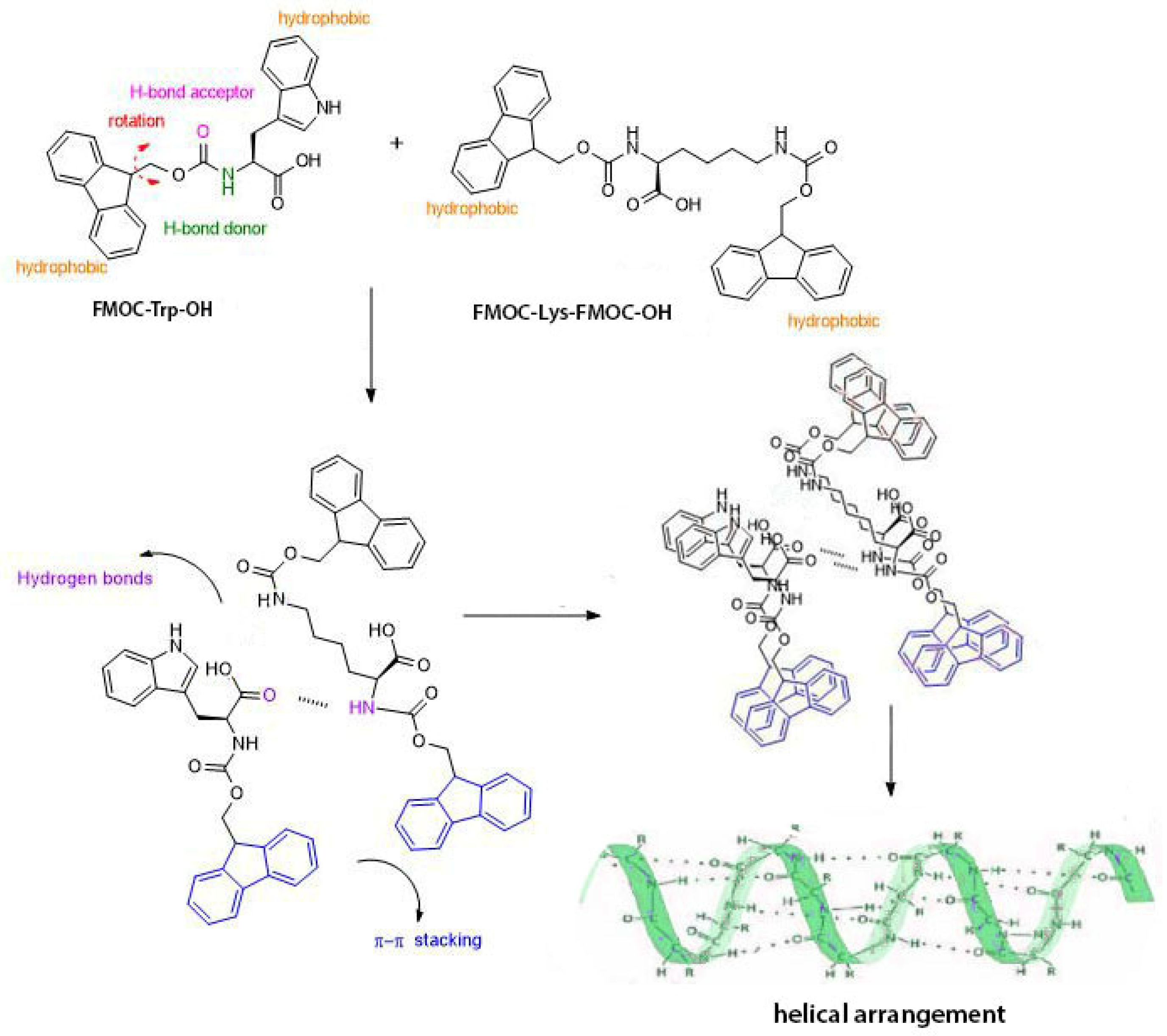
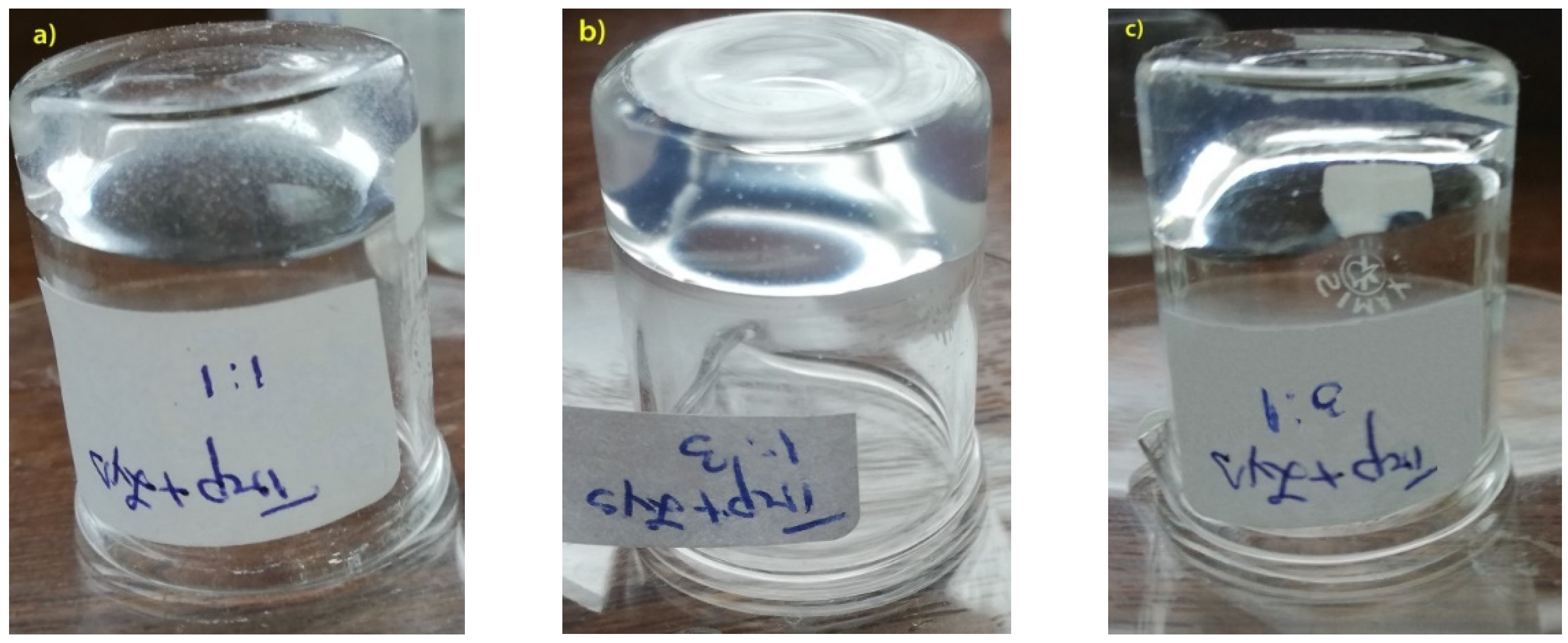
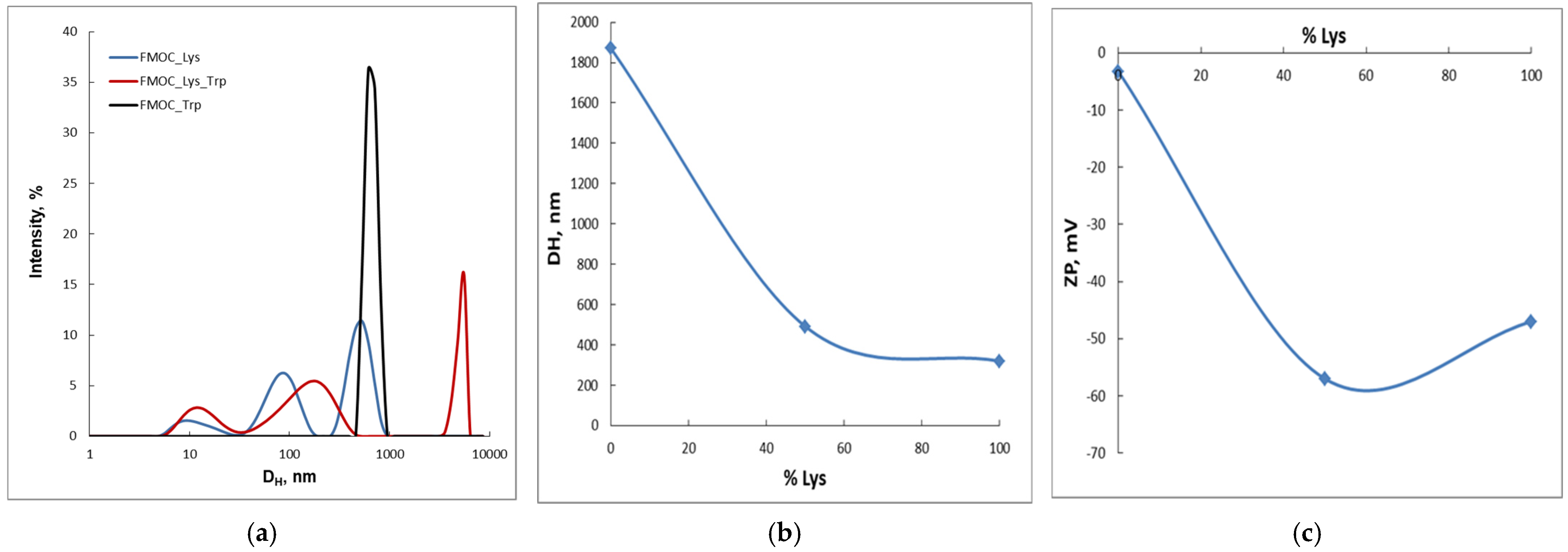



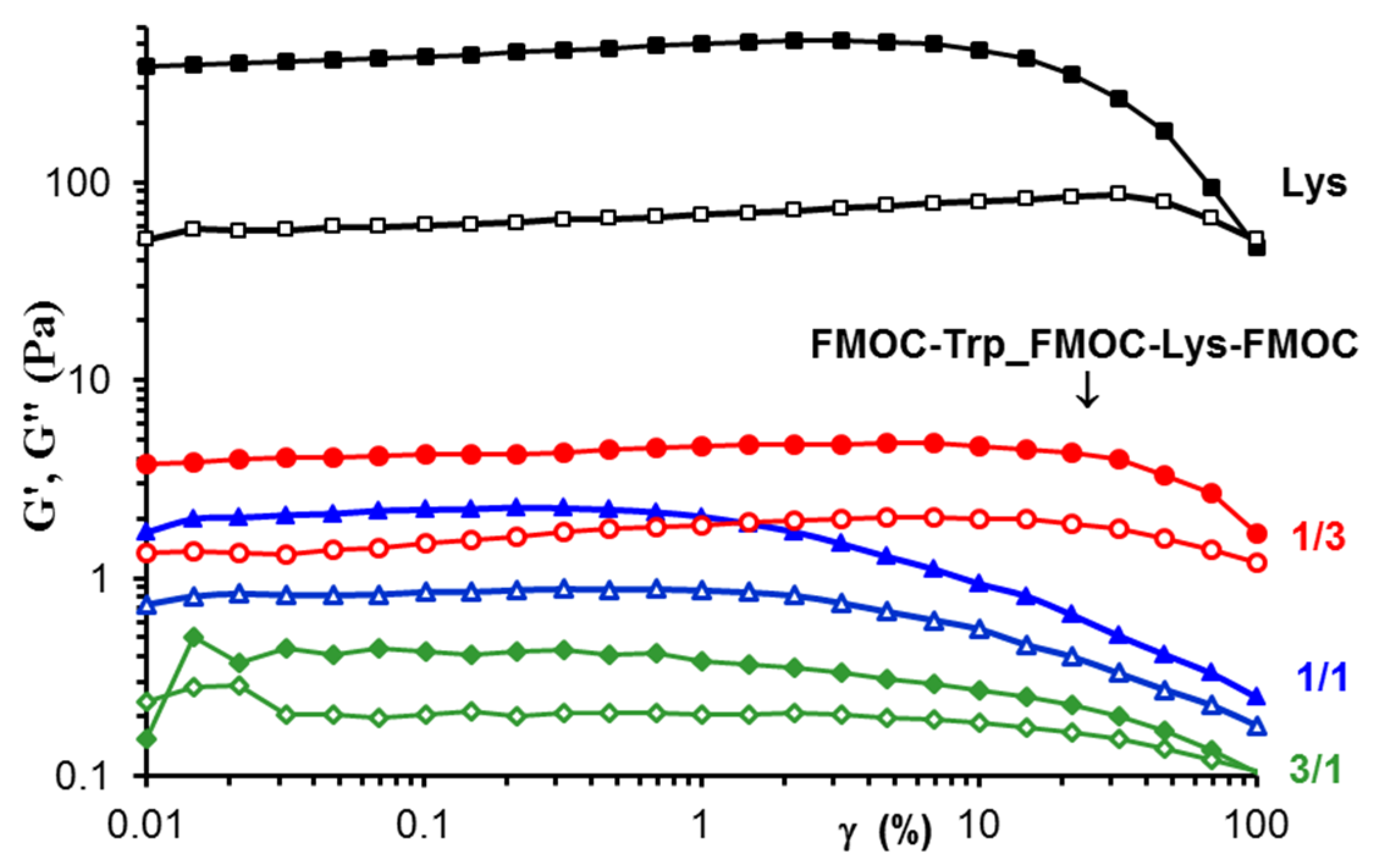
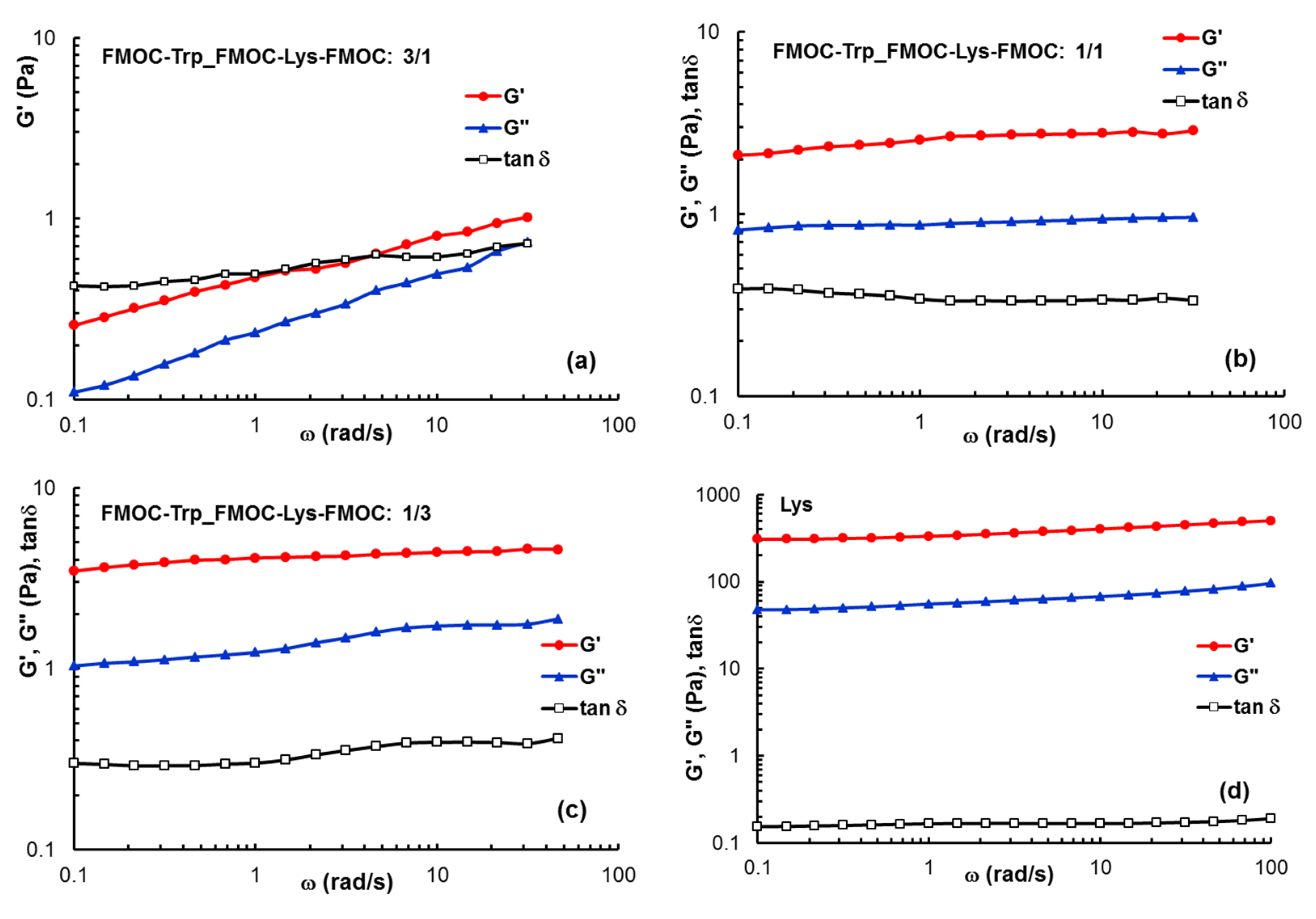
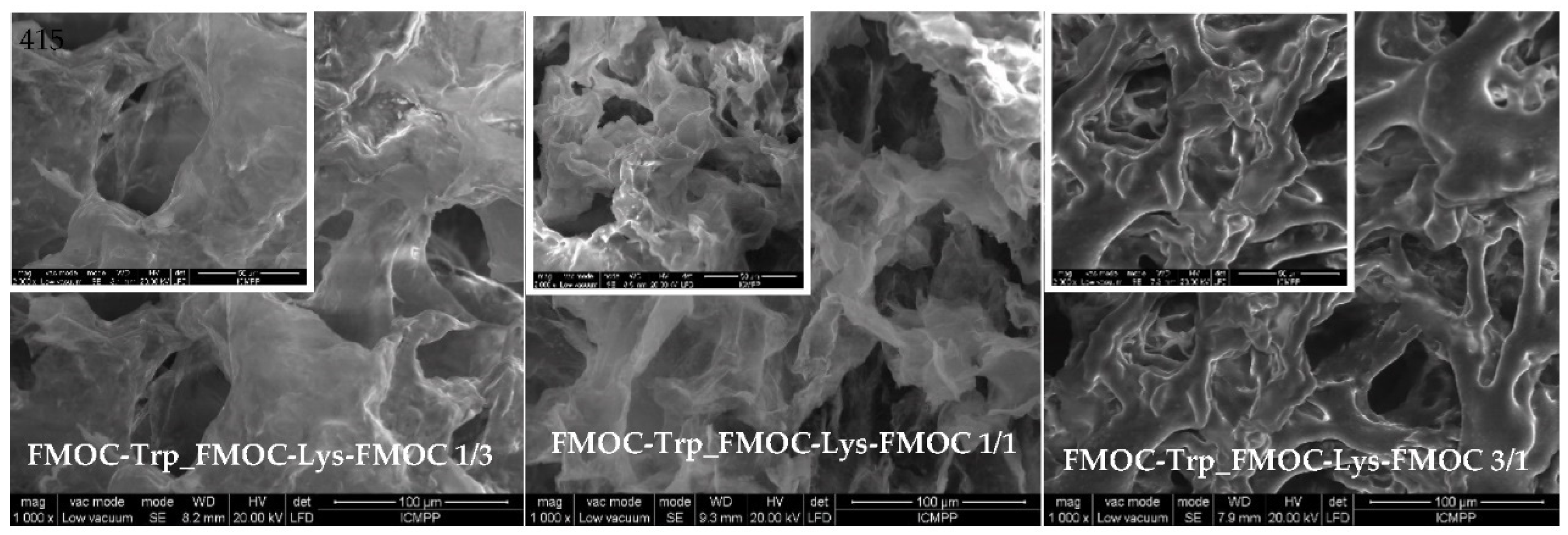
| FMOC_Lys_FMOC–OH | FMOC–Trp_FMOC–Lys–FMOC: 1/3 | FMOC–Trp_FMOC–Lys–FMOC: 1/1 | FMOC–Trp_FMOC–Lys–FMOC: 3/1 | FMOC–Trp_OH | |
|---|---|---|---|---|---|
| N–H 2 peaks primary amine/ 1 peak secondary amine | 3343 and 3379 | 3424 and 3329 | 3418 and 3327 | 3418 | 3426 and 3347 |
| C–H alkane | 3046 | 3057 | 3055 | 3055 | 3046 |
| C–H stretching Aromatic ring | 2947 | - | 2940 | 2942 | 2951 |
| C=O as stretching amide I band | 1689 | 1695 | 1703 | 1705 | 1736 |
| C–N Amide II band | 1531 | 1535 | 1533 | 1522 | 1520 |
| CH2 | 1448 | 1446 | 1446 | 1443 | 1444 |
| C–Namide III band | 1250 | 1257 | 1253 | 1252 | 1219 |
| C–O stretching | - | 1155 | 1161 | 1169 | - |
| C–O | 1062 | 1076 | 1068 | 1068 | 1091 |
| Aromatic ring | |||||
| C=C C–C C–H | 945 864 736 | 940 860 742 | 947 858 744 | 947 860 744 | - 879 748 |
| Sample | Degradation Stage | Tonset (°C) | Tpeak (°C) | Tend (°C)) | W (%) | Residue | T10 (°C) | T20 (°C) | Tg (°C) |
|---|---|---|---|---|---|---|---|---|---|
| FMOC_Trp_FMOC–Lys–FMOC: 1/3 | I | 157 193 317 | 161 | 184 282 356 | 11.98 | 32.51 | 171 | 202 | |
| II | 204 | 34.98 | 34.5 | ||||||
| III | 329 | 20.53 | |||||||
| FMOC–Trp_FMOC–Lys–FMOC: 1/1 | I | 105 | 140 | 167 | 9.59 | 29.48 | 169 | 196 | |
| II | 183 | 197 | 205 | 17.12 | 30.1 | ||||
| III | 263 | 291 | 305 | 24.40 | |||||
| IV | 315 | 332 | 368 | 19.41 | |||||
| FMOC–Trp_FMOC–Lys–FMOC: 3/1 | I | 136 | 163 | 174 | 20.06 | 27.69 | 152 | 174 | |
| II | 171 | 203 | 224 | 12.41 | 48 | ||||
| III | 216 | 282 | 295 | 12.29 | |||||
| IV | 290 | 329 | 370 | 27.55 |
| Sample | Composition for a Volume of 5 mL Sample |
|---|---|
| FMOC–Trp_FMOC–Lys–FMOC: 1/3 | 1.25 mL FMOC–Trp–OH added over 3.75 mL FMOC–Lys–FMOC–OH |
| FMOC–Trp_FMOC–Lys–FMOC: 1/1 | 2.5 mL FMOC–Trp–OH added over 2.5 mL FMOC–Lys–FMOC–OH |
| FMOC–Trp_FMOC–Lys–FMOC: 3/1 | 3.75 mL FMOC–Trp–OH added over 1.25 mL FMOC–Lys–FMOC–OH |
Publisher’s Note: MDPI stays neutral with regard to jurisdictional claims in published maps and institutional affiliations. |
© 2021 by the authors. Licensee MDPI, Basel, Switzerland. This article is an open access article distributed under the terms and conditions of the Creative Commons Attribution (CC BY) license (https://creativecommons.org/licenses/by/4.0/).
Share and Cite
Croitoriu, A.; Nita, L.E.; Chiriac, A.P.; Rusu, A.G.; Bercea, M. New Physical Hydrogels Based on Co-Assembling of FMOC–Amino Acids. Gels 2021, 7, 208. https://doi.org/10.3390/gels7040208
Croitoriu A, Nita LE, Chiriac AP, Rusu AG, Bercea M. New Physical Hydrogels Based on Co-Assembling of FMOC–Amino Acids. Gels. 2021; 7(4):208. https://doi.org/10.3390/gels7040208
Chicago/Turabian StyleCroitoriu, Alexandra, Loredana E. Nita, Aurica P. Chiriac, Alina G. Rusu, and Maria Bercea. 2021. "New Physical Hydrogels Based on Co-Assembling of FMOC–Amino Acids" Gels 7, no. 4: 208. https://doi.org/10.3390/gels7040208
APA StyleCroitoriu, A., Nita, L. E., Chiriac, A. P., Rusu, A. G., & Bercea, M. (2021). New Physical Hydrogels Based on Co-Assembling of FMOC–Amino Acids. Gels, 7(4), 208. https://doi.org/10.3390/gels7040208







